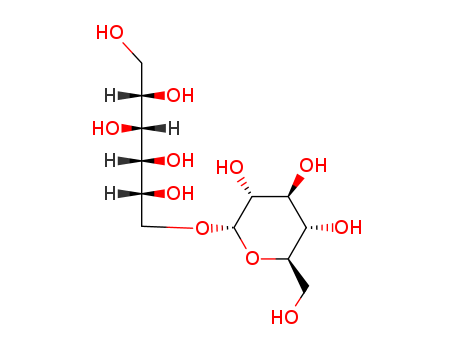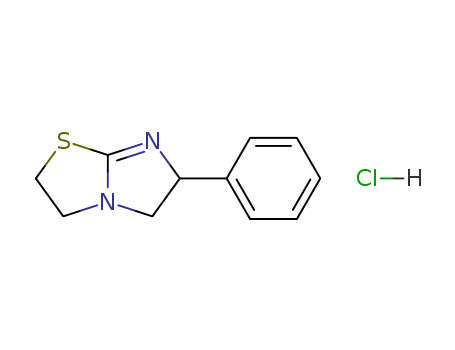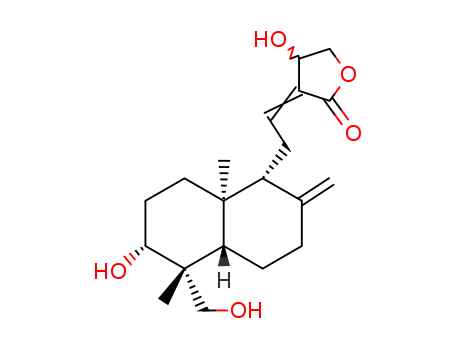
5508-58-7
- Product Name:Andrographolide
- Molecular Formula:C20H30O5
- Purity:99%
- Molecular Weight:350.45
Product Details;
CasNo: 5508-58-7
Molecular Formula: C20H30O5
Appearance: powder
Andrographolide 5508-58-7 In Medicine, Good Supplier In China with Fast Delivery
- Molecular Formula:C20H30O5
- Molecular Weight:350.45
- Appearance/Colour:powder
- Vapor Pressure:9.64E-15mmHg at 25°C
- Melting Point:229-232 °C(lit.)
- Refractive Index:1.567
- Boiling Point:557.3 °C at 760 mmHg
- PKA:12.36±0.20(Predicted)
- Flash Point:195.5 °C
- PSA:86.99000
- Density:1.21 g/cm3
- LogP:1.96260
Andrographolide(Cas 5508-58-7) Usage
|
Description |
Andrographolide is the bitter principle, a colorless and neutral crystalline substance. It is the major labdane diterpenoid isolated from Andrographis paniculate. It exhibits antiviral, anti-inflammatory, and anticancer activities. The underlying mechanism is the inhibition of the mitogen-activated protein kinase/extracellular signal-regulated kinase (MAPK/ERK) signaling (specifically p38 MAPK/ERK1/2) pathway and downstream transcription factors such as nuclear factor kappa B (NF-κB) and nuclear factor of activated T cells (NFAT). Andrographolide is also confirmed with chemopreventive effects against and the inhibitory effects on cancer cell growth in breast, colon, epidermoid, gastric, liver, leukemia, myeloma, peripheral blood lymphocytes, and prostate cancers. Andrographolide has been used for liver complaints and fever, and as an anti-inflammatory and immunostimulant. Andrographolide exerts anti-growth and pro-apoptotic effects on human rheumatoid arthritis fibroblast- like synoviocytes, the main cellular constituent of pannus, that combined with a massive infiltration of lymphocytes and macrophages, invades and destroys the local articular structure. Thereby, andrographolide is proposed to be used in Rheumatoid Arthritis and other autoimmune diseases. |
|
Chemical Properties |
white square prism or flaky crystals (ethanol or methanol) and odorless, with a bitter taste. dissolved in boiling ethanol, slightly soluble in methanol or ethanol, very slightly soluble in chloroform, and almost insoluble in water. Since andrographolide has an ester structure, it is easy to hydrolysis, open loop and isomerization in the aqueous solution to affect the drug stability. At lower temperature, the stability of andrographolide is better; it is unstable in alkaline conditions, and its instability increased with the increase in alkaline strength. The most stable pH value is 3–5. Andrographolide is more stable in chloroform. |
|
Occurrence |
Andrographis is found growing wild in India and Sri Lanka and is cultivated in many other parts of the world. |
|
Uses |
Andrographolide is a labdane diterpenoid. Andrographolide is the main bioactive component isolated from the medicinal plant Andrographis paniculata. It has a broad range of therapeutic applications including anti-inflammatory and anti-platelet aggregation activities and potential antineoplastic properties. Andrographolide showed significant antihepatotoxic action in P. berghei K173- induced hepatic damage in M. natalensis. Andrographolide inhibits tumor necrosis factor-α (TNF-α)-induced intercellular adhesion mol.-1 (ICAM-1) expression and adhesion of HL-60 cells onto human umbilical vein endothelial cells (HUVEC), which are associated with inflammatory diseases. These findings suggest that Andrographolide may have potential as a cardiovascular-protective agent. |
|
Definition |
ChEBI: Andrographolide is a labdane diterpenoid isolated from the leaves and roots of Andrographis paniculata that exhibits anti-HIV, anti-inflammatory and antineoplastic properties. It has a role as a metabolite, an anti-inflammatory drug, an anti-HIV agent and an antineoplastic agent. It is a gamma-lactone, a primary alcohol, a secondary alcohol, a labdane diterpenoid and a carbobicyclic compound. |
|
Application |
Andrographolide may be used as a reference standard for the determination of andrographolide in:Leaves of Andrographis paniculata by soxhlet extraction-recrystallization-column chromatography purification followed by analyses using reversed phase high performance liquid chromatography (RP-HPLC) as well as gas chromatography-mass spectrometry (GC-MS).Roots of Andrographis paniculata by HPLC with diode array detection (DAD), gas chromatography-mass spectrometry (GC-MS) and LC coupled to tandem mass spectrometry (MS/MS) equipped with electrospray ionization (ESI) and multiple reaction monitoring (MRM) mode of detection.Stems of Andrographis paniculata by ultra-HPLC combined coupled to triple quadrupole-linear ion trap mass spectrometry (QqQLIT-ESI-MS/MS) with MRM detection.Rat plasma samples by protein precipitation and subsequent ESI-LC-MS/MS determination using MRM detection. |
|
General Description |
Andrographolide, a bioactive diterpene lactone, is the main constituent of Andrographis paniculata, a plant used in traditional medicines. It is known to have different biological activities such as anti-inflammatory, anti-malarial, anti-cancer and hepatoprotective activity. It also shows potent anti-viral effect against dengue virus. |
|
Biochem/physiol Actions |
Diterpenoid lactone with anti-inflammatory properties. It blocks T-cell proliferation to allogenic stimuli and the chemotactic migration of macrophages induced by complement. Blocks the proliferation of several cancer cell lines in vitro. |
|
Anticancer Research |
It is a labdane diterpenoid, which shows cytotoxic effect against different cancercell lines like human epidermoid cancer cells (KB), lymphocytic leukemia cells(P388), breast cancer cells (MCF-7), and colon cancer cells (HCT-116). It inhibitsthe proliferation of colon cancer cells (HT-29) and exerts pro-differentiative effecton mouse myeloid leukemia M1 cell line (Desai et al. 2008). |
|
Clinical Use |
This product is commonly used clinically for dysentery, leptospirosis, meningitis, pneumonia, upper respiratory tract infection, and enhancing adrenal cortical function. In view of the requirement for clinical viral infection emergency, it is important to introduce the hydrophilic group in different lactone structure, enhance its water solubility, and improve efficacy. There are a variety kinds of andrographolide injection, including potassium dehydroandrograpolide succinate needle, potassium sodium dehydroandrographolide succinate needle. Lianbizhi is the representative of this class of drugs in current clinical application. Oral administration of andrographolide may induce bitter vomiting. Oral administration of this product and other preparations in large doses can cause epigastric discomfort and loss of appetite. It had been reported of drug eruption, upper abdominal pain, and anaphylactic shock caused by intramuscular injection. Severe symptom response emerged such as chest tightness, shortness of breath, pallor, lip bruising, cold sweats, weak pulse, decreased blood pressure, etc. Light reactions include abdominal pain, vomiting, asthma, urticaria, pimples, dizziness, head swelling, sneezing, chest pain, etc. The reaction is real time and also 5–20?min after injection and gradually improves 5–45?min after rescue and individual recovered by 24?h. There are also reports of acute amniotic fluid blockage caused by weaning lotion exchange. In addition, taking into account the adverse effects of andrographolide on reproduction, it is recommended to be used cautiously by fertility couples and pregnant women. |
|
in vitro |
andrographolide was found to suppress the expression of inducible nitric oxide synthase in a concentration-dependent manner. in the andrographolide-treated group, a reduction of akt, c-jun n-terminal kinase and p65 phosphorylation was observed. andrographolide also caused a decrease in bcl-2/nf-κb expression and a dose-dependent increase in the expression of cleaved-caspase3/bax protein [1]. |
|
in vivo |
rats were dosed with andrographolide intragastrically for 5 consecutive days in a hepatoprotection study. results indicated that andrographolide could up-regulate glutamate cysteine ligase catalytic and modifier subunits, heme oxygenase-1, superoxide dismutase-1, glutathione s-transferase protein and mrna expression in the heart, liver, and kidney [2]. |
|
IC 50 |
11.0 ± 0.28 μg/ml for α-glucosidase; 11.3 ± 0.29 μg/ml for α-amylase |
InChI:InChI=1/C20H30O5/c1-12-4-7-16-19(2,9-8-17(23)20(16,3)11-21)14(12)6-5-13-15(22)10-25-18(13)24/h5,14-17,21-23H,1,4,6-11H2,2-3H3/b13-5+/t14-,15-,16?,17-,19+,20+/m1/s1
5508-58-7 Relevant articles
Enantioselective Total Synthesis of Andrographolide and 14-Hydroxy-Colladonin: Carbonyl Reductive Coupling and trans-Decalin Formation by Hydrogen Transfer
Krische, Michael J.,Sharma Poudel, Binit,Wurm, Thomas,Yang, Lin
, p. 23169 - 23173 (2020/10/19)
An enantioselective total synthesis of t...
5508-58-7 Process route
-
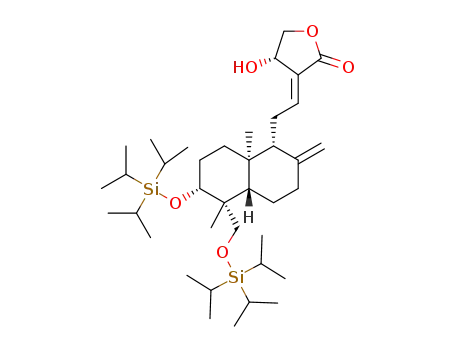
-
(S,E)-3-(2-((1R,4aS,5R,6R,8aS)-5,8a-dimethyl-2-methylene-6-((triisopropylsilyl)oxy)-5-(((triisopropylsilyl)oxy)methyl)decahydronaphthalen-1-yl)ethylidene)-4-hydroxydihydrofuran-2(3H)-one

-
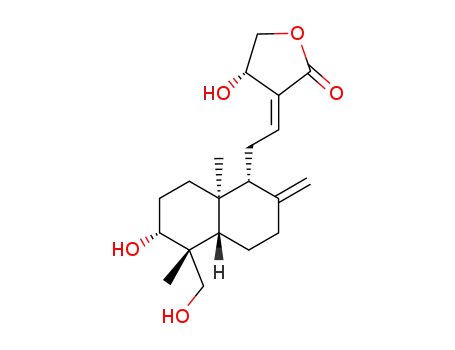
- 142037-79-4,5508-58-7
andrographolide
| Conditions | Yield |
|---|---|
|
With pyridine; pyridine hydrogenfluoride; In tetrahydrofuran; at 0 - 20 ℃; for 34h; Inert atmosphere;
|
92% |
-
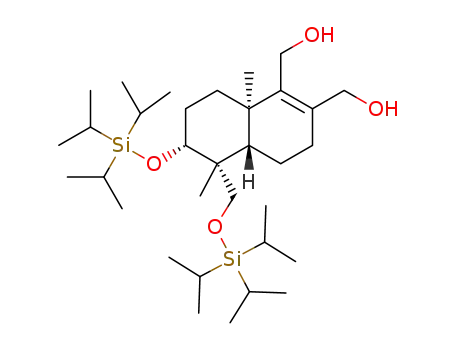
-
((4aS,5R,6R,8aR)-5,8a-dimethyl-6-((triisopropylsilyl)oxy)-5-(((triisopropylsilyl)oxy)methyl)-3,4,4a,5,6,7,8,8a-octahydronaphthalene-1,2-diyl)dimethanol

-

- 142037-79-4,5508-58-7
andrographolide
| Conditions | Yield |
|---|---|
|
Multi-step reaction with 5 steps
1.1: di-isopropyl azodicarboxylate; triphenylphosphine; 2-nitrobenzenesulfonyl hydrazide / tetrahydrofuran / 7.5 h / -30 - 25 °C / Inert atmosphere
2.1: triphenylphosphine; 1H-imidazole; iodine / tetrahydrofuran / 24 h / 0 - 20 °C / Inert atmosphere
3.1: tert.-butyl lithium / diethyl ether; pentane / 1 h / -78 °C / Inert atmosphere
3.2: 0.08 h / -78 - 0 °C / Inert atmosphere
4.1: triethylamine; palladium diacetate; 4,5-bis(diphenylphosphino)-9,9-dimethylxanthene; sodium carbonate; tetra-(n-butyl)ammonium iodide / 1,4-dioxane / 15 h / 80 °C / Inert atmosphere; Schlenk technique
5.1: pyridine hydrogenfluoride; pyridine / tetrahydrofuran / 34 h / 0 - 20 °C / Inert atmosphere
With pyridine; 1H-imidazole; di-isopropyl azodicarboxylate; 2-nitrobenzenesulfonyl hydrazide; iodine; tert.-butyl lithium; palladium diacetate; tetra-(n-butyl)ammonium iodide; sodium carbonate; pyridine hydrogenfluoride; triethylamine; triphenylphosphine; 4,5-bis(diphenylphosphino)-9,9-dimethylxanthene; In tetrahydrofuran; 1,4-dioxane; diethyl ether; pentane;
|
5508-58-7 Upstream products
-
624-15-7

geraniol
5508-58-7 Downstream products
-
42895-58-9
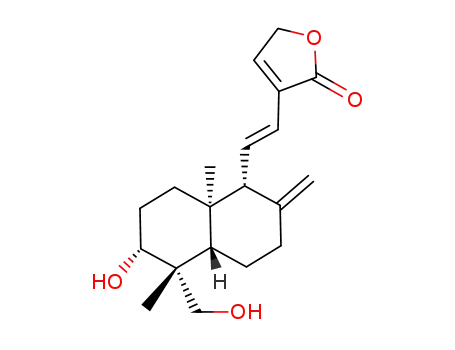
14-deoxy-11,12-didehydroandrographolide
-
92587-11-6
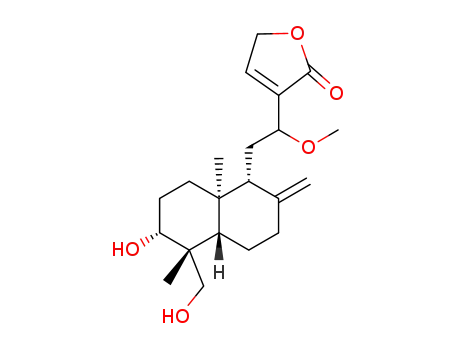
14-deoxy-12-methoxy-andrographolide
-
352661-68-8
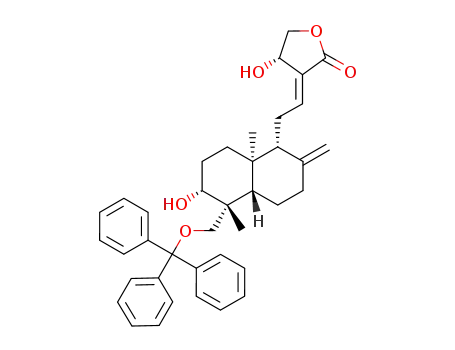
19-Tr-andrographolide
-
774581-41-8
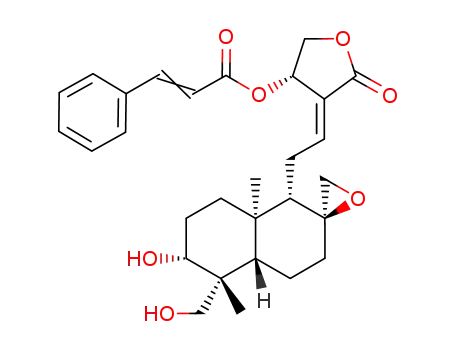
C29H36O7
Relevant Products
-
Isomaltitol
CAS:534-73-6
-
Tetramisole hydrochloride
CAS:5086-74-8
-
Carbomer
CAS:9007-20-9

